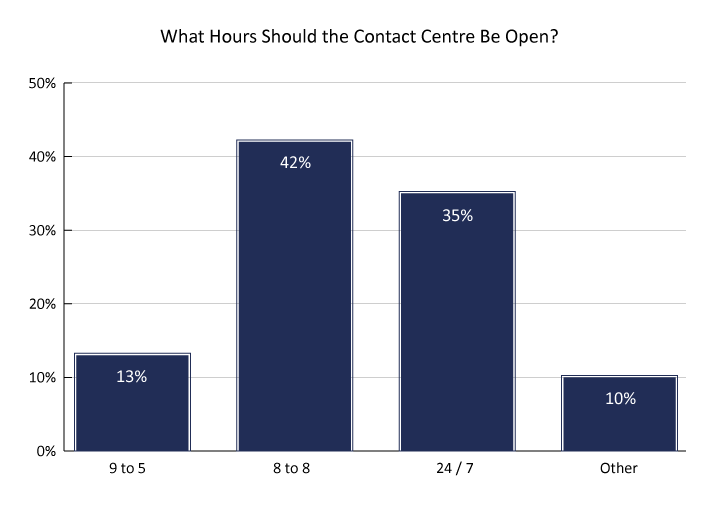The question many contact centre leaders find themselves asking is ‘what hours should the contact centre be open?’
In this article we delve into the factors that need to be considered when deciding on opening hours and how to determine what works for your contact centre.
Contact Centre Opening Hours Matter More Than You Think
The hours a contact centre is open for help determine the effectiveness, efficiency and reputation of the organization and the service provided.
It is, however, important that contact centres strike the right balance between managing operational costs and meeting customer needs.
Although it is not all-inclusive, one easy way to think about this is that the company’s hours of accessibility, locations of accessibility, and the potential urgency of the contacts, all determine potential opening hours.
For example, the following types of contact centre should offer 24/7 support:
- Emergency Services (Police, Fire, and Medical)
- Healthcare Providers (Hospitals, Clinics, Support Lines)
- Global Businesses and E-Commerce Providers
- Financial Institutions (Banks etc.)
- Travel and Hospitality (Airlines, Hotels, Rentals)
- Utilities (Electric, Water, Gas, Telecoms)
But what hours should your contact centre be open? Read on to discover what you need to take into account when making your decision.
Four Factors for Deciding Contact Centre Opening Hours
There are four main areas that need to be considered when determining what hours the contact centre should be open:
- Customers
- Data
- Employees
- Technology
So let’s take a quick look at each of these and how you can strategically determine your opening hours.
1. Customers
As the customer is central to your business success, you first need to consider them and what they need from the contact centre.
You can start by asking a few simple questions, such as:
- How do our customers contact us?
- Why do our customers contact us?
- What is our customer demographic?
- Where are our customers from?
- Are there specific times our customers contact us?
This is important as taking a customer-centric approach to deciding operating hours can be extremely beneficial, as customers who can easily and quickly access support are far more likely to be satisfied with the service they are receiving.
Taking note of which opening hours align with customer preference, availability, and requirements prepares you for the next stages of determining when your contact centre should be open.
2. Data
You shouldn’t just jump to conclusions about your opening hours based on the customers, though. Instead, you need to look at the data to help support any decisions you make.
You need to look through historical data and ask questions such as:
- What are the call volumes like and are there any trends?
- What are the interactions like on manned channels like chat, email, social, etc.?
- Are there peak contact times and does this vary by channel?
- What are the types of enquiries on each channel?
- Do we handle high-priority contacts that need to be dealt with urgently?
- What are our operational costs?
Knowing when customers are likely to contact you and the reasons can help you identify what hours your contact centre needs to offer full support, on which channels, and where you could offer alternative contact options.
Once you have the data, compare it with the needs of the customer and you can start to build a picture of the times your contact centre needs to be open to cater to your customers.
3. Employees
Next you need to account for the employees, who are just as important as the customers.
Not only do you need to make sure you have enough staff to operate the contact centre for any opening hours you are looking at, you also need to ensure that you take their wellbeing, preferences and feedback into account.
Happy staff equal happy customers, and contact centre leaders need to make sure that their staff have a work–life balance; irregular or extended working hours can lead to burnout, attrition, and reduced productivity, all of which negatively affects the customer and the business.
So when looking at the employees you need to ask questions such as:
- Do we have enough staff for the hours we want to be open?
- Do the employees have enough training?
- Do we have the right shift patterns and schedules?
- Do the employees have any feedback or suggestions on opening hours?
- Do we need to recruit more employees?
The goal here is to get the balance between a healthy working environment and meeting customer demands.
Remember that just because you can do something, doesn’t mean you should; it may not be financially viable to be open at non-peak times.
Once you have investigated your employee needs and feelings, you need to add this to the information on customer needs and check against the data to establish what your requirements and next steps are.
4. Technology
So now you have looked at the customer, the data, and the employees, you then have to look at the technology.
With the right technology you can effectively streamline your operations and make it easier to handle customer enquiries.
When looking at your technology you need to ask questions such as:
- Can we automate some of the routine enquiries?
- Do we have chatbots, self-service etc?
- Can we use technology to redirect customer enquiries or help them solve issues themselves?
- Do we need to invest in new technology?
Investing in technology such as chatbots, self-service, and automated systems allows contact centres to handle routine contacts and enquiries outside of working hours with no employee involvement.
This provides customers with immediate assistance with 24/7 availability without adding further burdens on operational costs and employees.
So to determine when your contact centre should be open, look at what you have in place to handle customers, and by taking into account these four factors you can strategically determine what hours your contact centre needs to be open and identify what you need to do to achieve this.
Remember It’s a Balancing Act

Patterson
Deciding which hours your contact centre should be open involves a multifaceted approach, taking into account customers, data, employees, and technology.
There is no one-size-fits-all, but with customer-centricity in mind, contact centres can find a solution that ensures a great quality accessible service, whilst ensuring employee wellbeing and utilizing technology.
Nikki Patterson, Resource Planning Analyst, Sage, aptly summarized this:
“Contact centre opening hours should be based around your customer type and demand, whilst maintaining a work–life balance for your employees.
“Speak to your customers and learn how their business works and when they will need you most.
“Use historical data to make informed decisions around opening hours. Where call volume is low, explore other forms of contact for customers.
“This could reduce staffing requirements outside of the busy period, and increase available agents during peak periods. Increasing staffing during busier periods without having to hire cuts costs, reduces abandoned calls and potential complaints.
“I have found this brings a much happier workforce and reduces sickness. The world today is all about work–life balance, so a contact centre getting their opening hours right for both customer and employees is vital to this.
“Each business has different requirements, so I believe it’s important to be close to your customers and listen to their needs as a starting point.”
Make Sure You Publicize Your Opening Hours
There is nothing more frustrating than having an issue and needing to contact customer service and finding the publicized opening hours are either not available or are incorrect.
Just remember that whatever opening hours you decide for your contact centre, you need to make sure these are clearly mentioned on your website and other correspondence, so there is no confusion for your customers.
It’s a simple and quick task that can make the world of difference to your customers.
And Finally …
To help you make a decision, we asked our LinkedIn Community and our LinkedIn Company Followers ‘What Hours Should the Contact Centre Be Open?’

| Opening Hours | Response % |
|---|---|
| 9 to 5 | 13% |
| 8 to 8 | 42% |
| 24 / 7 | 35% |
| Other | 10% |
312 industry professionals responded and, interestingly, 8 to 8 was the most popular choice, followed closely by 24/7.
There were also a number of comments from the participants, providing more information on their response as well as advice.
Opening Hours Depend on Service

The opening times depend on what service the contact centre is supporting. If it is insurance or road rescue, you would expect to be able to speak to somebody 24/7.
Contributed by: Kim Ellis, LN Director & Chief Learning Architect at Go Ginger Learning Solutions.
Great CX Has No Barrier
There should be no barrier to great CX
Contributed by: Mark Hawkes, Digital Marketing Specialist at Uniphore
Three Hours on Either Side of the Operating Hours

I think it depends on the type of service that is offered. We used to talk about mission-critical services such as banking, travel and utilities. In our 24-hour-day society these should be open.
But for most of the rest I would think that three hours on either side of the operating hours would be a good guide.
However, given the complexity of CX and its general lack of alignment to customers (which has got worse over the last five years), I would still expect an organization who cared about their customers to have a single emergency number 24/7.
Contributed by: Morris Pentel, Principal Consultant & Customer Success Director
9 to 5 Is Inconvenient for Customers
It depends on the nature of the business and the overall customer strategy. That should inform opening hours.
Personally, nothing irks me more than a 9-to-5 contact centre because it usually means I have to take time out of my working day to conduct my personal business, and if said contact centre isn’t resourced correctly, that can mean queuing time too.
Contributed by: Katriona Dixon, Transition Director
Remote Call Answering Can Be Activated 24/7
Remote call answering can be activated 24/7 for enquiries, with a live voice to take details. This can be cost effective and 100% better than a voicemail giving opening times. It’s not for everyone, of course, but it sure works for most.
Contributed by: Simon Kenna
Support Can Be Available 24/7 for Many of the Basics

It depends on the nature of the business and consumer needs.
With the advent of conversational AI, support can be available 24/7 for many of the basics.
If your customer base is global, 24/7 is a must, with staffing determined by demand.
Contributed by: Roy Atkinson, CEO at Clifton Butterfield, LLC
Depends on the Nature of the Call Being Handled
It depends on the nature of call being handled. If it’s B2B then 9-5 is fine but B2C often needs to be longer hours as there may be emergency situations that need dealing with.
Contributed by: Sean White
If you are looking for more on opening hours – you should read this article next:
Author: Robyn Coppell
Reviewed by: Hannah Swankie
Published On: 16th Apr 2024 - Last modified: 23rd Oct 2025
Read more about - Customer Service Strategy, Customer Expectations, Customer Service, Kim Ellis, Morris Pentel, Research, Roy Atkinson, Service Strategy, Shift Patterns, Top Story, Workforce Management (WFM)




















